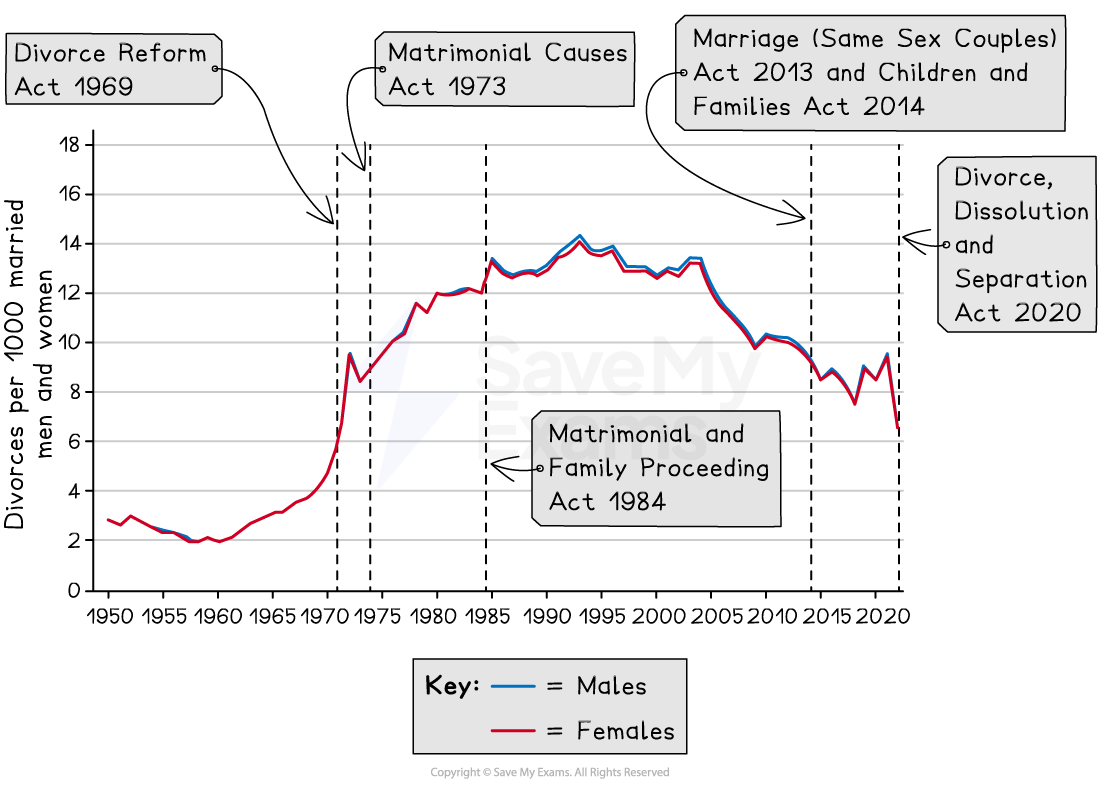Divorce (AQA A Level Sociology): Revision Note
Exam code: 7192
Changing pattern of divorce
Divorce is the legal termination of a marriage
Since the 1960s, divorce rates in the UK have risen significantly
1961: 27,000 divorces
1993: Peak of 165,018 divorces
2012: 118,140 divorces
2022: 80,057 divorces
Divorce rates have declined slightly in recent years but remain higher compared to pre-1960 levels
Most divorces involve couples in their late 30s to 40s, typically after 10–20 years of marriage
Divorce statistics do not reflect the number of 'empty shell' marriages
Reasons for the increase in divorce
Declining stigma and changing attitudes
Divorce is now viewed as more acceptable and less stigmatised
High-profile celebrity divorces (e.g., within the Royal Family) normalise divorce as a solution to marital breakdown
Secularisation
Decline in religious influence has weakened opposition to divorce
Fewer couples marry in religious ceremonies, reducing church control over marriage
Rising expectations of marriage
Fletcher (1966): Marriage is now seen as a relationship based on personal fulfilment and romantic love
Individuals are less willing to stay in unhappy marriages, contributing to higher divorce rates
Women, in particular, are less willing to tolerate dissatisfaction, with 75% of divorces initiated by women
Women’s increased financial independence
Women have better education, careers, and financial stability, reducing dependence on men
Welfare benefits provide some support for single mothers, making divorce a viable option
Feminist explanations
Women carry a dual burden of paid work and housework, creating tension within marriages
Hochschild (1997): Women feel more valued at work but face frustration at home due to men's resistance to housework
Duncombe and Marsden (1993): The 'triple shift' (work, domestic labour, emotional work) contributes to marital dissatisfaction
Changes in law
Divorce Reform Act (1969): Implemented in 1971, allowing divorce based on "irretrievable breakdown of marriage" (adultery, desertion, unreasonable behaviour)
Matrimonial Causes Act (1973): Initially required a three-year minimum marriage length, reduced to one year in 1984
Legal aid (1949): Made divorce more affordable until funding cuts in 2013 limited availability
No-fault divorce: Introduced by the Divorce, Dissolution and Separation Act (2020), allowing couples to divorce without assigning blame

Sociological perspectives
New Right
Rising divorce undermines traditional family values and social stability
Divorce creates a "dependency culture" and an underclass of welfare-dependent lone parents
Divorce leads to negative outcomes for children (e.g., poorer health and educational achievement)
Functionalists
High divorce rates reflect higher expectations of marriage, not a decline in its importance
High remarriage rates show continued commitment to marriage as an institution
Divorce allows individuals to seek happier, more functional partnerships
Feminists
Rising divorce rates are seen as a positive sign of female empowerment, enabling women to leave oppressive relationships
Duncombe and Marsden (1993): Emotional neglect and inequality at home drive women to file for divorce
Interactionists
Morgan (1996): Divorce has different meanings for individuals, depending on their personal experiences
For some children, divorce can bring relief; for others, it can be traumatic
Personal life perspective
Divorce may cause challenges (e.g., financial hardship, less contact with non-resident parents)
However, Smart (2011) argues that divorce is simply one of many life transitions and does not necessarily harm the family
Theories of late modernity
Beck and Giddens: Individuals seek 'pure relationships' which are based on emotional satisfaction rather than duty
Greater personal freedom, secularisation, and choice have made divorce a normal part of modern life
Consequences of divorce
Divorce has significant consequences for
family members
the extended family
the overall structure of the family
Rising divorce rates are closely linked to an increase in lone-parent families and reconstituted (step) families
Changes to family structure
There are now more reconstituted/blended families
Adjusting to new family members can be challenging, as children and adults may need to adapt to different roles, routines, and behavioural expectations
However, reconstituted families can provide more sources of care, love, and emotional support, which can benefit children
Co-parenting challenges often arise, as most children live with their mothers post-divorce and may struggle to maintain regular contact with their father
It is estimated that 33–50% of divorced fathers gradually lose all contact with their children
Financial hardship
Divorce typically results in financial strain as assets are divided and households have less income to rely on
Lone parents with dependent children are particularly vulnerable to poverty and financial insecurity
Balancing the demands of paid work with parenting responsibilities can become more difficult for divorced individuals
Remarriage
Remarriage rates in England and Wales have declined
1995–2000: 19% of all marriages were remarriages
2013: This dropped to 15%
People remarry for various reasons:
Continuing belief in the institution of marriage, with hope that the second marriage will succeed
Child-rearing support, especially for divorcees with young children
Companionship and love
Relationship breakdown and emotional distress
Post-divorce, disputes over parenting, custody, and property may continue
Children’s relationships with their fathers often deteriorate, particularly if they live with their mother
The father’s side of the family (e.g., grandparents) may see less of the children in reconstituted family setups
Groups, such as Fathers4Justice (F4J), campaign to highlight the lack of legal rights for fathers to maintain contact with their children
Divorce can cause emotional distress due to changes in social and family networks
Men are more likely to lose emotional support if friendships or kinship ties weaken
Women are often better supported by strong social networks
For some, divorce brings emotional relief and positive outcomes, particularly if the marriage was unhappy or abusive

Unlock more, it's free!
Did this page help you?